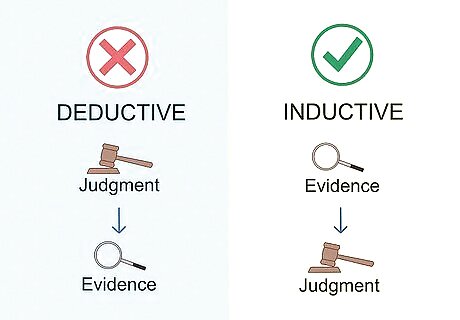
views
What does it mean to read minds?

Reading minds is piecing together cues to figure out what a person is thinking. It isn’t quite telepathy—or using some kind of supernatural power to read people’s exact thoughts—but it is about having what some psychologists call “empathic accuracy,” where you’re clued in to how another person is feeling. These cues can come from another person’s body language, their backgrounds, and paying attention to the details and style in which they say things. For example, someone might cross their arms when they're angry or upset. Some scientists also refer to “mind-reading motivation,” which is a skill that allows people to better understand the mental states of others. For example, someone with high mind-reading motivation might notice their colleague is anxious because they keep drumming their fingers.

Reading minds is also called “mentalizing." We actually do this all the time—you probably try to figure out what someone else is thinking at least a couple times a day. You may not even be fully conscious of doing this—mentalizing can happen even when you’re thinking of something completely different. Being able to mentalize and understand other people’s emotional states can be a very valuable skill in the workplace, at school, or in your personal life. Anyone working in an area where they have to understand other people well—like diplomats, healthcare workers, or businesspeople—can benefit a lot from honing their mentalization skills. Studies have shown that women tend to be better at mentalizing than men. People with autism may find mentalizing to be difficult. Many people with autism have strategies like practicing conversations ahead of time to manage their difficulties understanding other people’s emotions.

Reading minds is never an exact science, so be careful. Avoid assuming that you know what another person is thinking or feeling with 100% certainty—with mind reading, you’re making an educated guess, which means you’re likely to be wrong on occasion. Remember that other people are the authority on their own feelings, so try not to think you know what they need better than they do.
How to Read Minds in Your Daily Life

Listen carefully to both words and silences. When someone is speaking to you, ask yourself what the most important things they’re communicating are. Use active listening skills: avoid interrupting them, listen, ask questions, give them time to answer, and listen some more. Deep conversations aren’t the only way to understand someone else. Small talk gives you a chance to see how someone acts normally and when they’re in a relaxed state. For example, if a friend seems bubbly and talkative when you’re discussing the weather, but takes longer to respond and gives you ambiguous answers when you ask them how their family is doing, family could be a difficult subject for them. You might say something like, “How is your sister?” and be met with a moment of silence before your friend responds “I think she’s doing good.” In this example, your friend might be having some relationship difficulties with their sister, since they said “I think” instead of “She’s doing good.”

Observe their body language. Reading body language is a key tool for understanding other people’s mental states, but it can take some practice to learn. Body language can reveal things about people that they don’t want to say, or that they may not even be aware of themselves. If someone is saying “yes,” but their body language says “no,” it can alert you that something is off. There are whole books written just on body language, but to get started, here are the things you should look out for: Eyes: When people see something that excites them, when they’re making a hard choice, or when they’re experiencing strong feelings, their pupils tend to get bigger. Posture: Does the person you’re talking to seem stiff and tensed up, or relaxed? This can give you a clue as to how stressed they are. Facial expressions: A genuine smile involves more than just the lips. If someone is truly smiling, you’ll likely see laugh lines or small wrinkles around their eyes. Someone who is frowning might be upset or angry. Hand gestures: Someone who’s nervous might be restlessly playing with a pencil or another object in their hands. Tone of voice: A person who is comfortable generally has a relaxed, warm, or confident tone of voice. On the flip side, you might notice that the person sounds annoyed or angry.

Reflect on their background. Age, culture, and beliefs all have an important impact on what someone is thinking at any given time. Use your knowledge of someone else’s background to help you piece together their mindset. For example, if you’re pitching a business deal to an older person, they might be more concerned about risk than a younger person, who could be excited by it. Someone from a more traditional and introverted culture may refuse to be controversial, even when they’re upset.

Use your own sense of empathy. Sensory awareness is a term that means the awareness of how your own body is feeling in relation to the world around you. Seeing others in pain or suffering can activate your own body’s sense of suffering. If someone is causing you to feel extremely sad or happy, take this as a signal to think about if they might be feeling these emotions themselves.
What other ways can you read minds?

Their writing: In their texts or e-mails, what subjects do they seem to be most interested in? If they’ve published any blogs or public-facing writing, read those. How do their tone and word choices change when talking about things they feel passionate about? For example, if someone you’re interested in has a travel blog, they’ll likely feel a connection to you if you appeal to their sense of adventure.

Their social media: The things people post about and the tone they use in their posts can clue you into their thoughts and feelings about all kinds of issues. You can even tell how comfortable someone is in social situations through social media: introverts tend to use more words focusing on themselves, like “I,” while extraverts tend to use words reflecting social activities, like “love,” “night,” or “party.” If you want to get to know someone’s mindset better through social media, try seeing what accounts they follow to get an idea of their interests.

Their close friends’ opinions of them: People who are close to someone who you want to understand better are likely to have a good idea of their likes and dislikes, as well as how they would react in certain situations. Try asking a friend or family member of someone you’re interested in about what that person might think about a certain subject. For example, if you’re trying to find out what activities someone might like doing on a date, try asking their sibling a question like, “What kind of food does your sister like?”

Their personal style and appearance: Someone wearing a fur coat, for example, isn’t likely to be an animal rights activist. Keep in mind that there are limits to how much you can understand from someone’s appearance—a uniform says more about where someone works than who they are. As an example, if someone has dyed their hair an unusual color and wears edgy clothing, they’re likely to have unconventional or open-minded opinions about social issues.
Becoming a Better Mind Reader

Set aside your own biases and judgments. Try to be open-minded when considering how someone else might feel. Remember that just because you would react in a certain way doesn’t mean someone else would. For example, just because you would be upset if someone else cancelled plans at the last moment, this doesn’t mean that someone else is.

Practice inductive reasoning. While deductive reasoning starts from a premise and then tries to find evidence to support it (“he’s mad, so he’s looking at the ground”), inductive reasoning does the complete opposite (“he’s looking at the ground, so he may be mad”). The key to mind-reading is to gather evidence before you make a judgment on how someone might be feeling, rather than the other way around. People with social anxiety often struggle with using deductive reasoning instead of inductive reasoning. If you assume that people are judging you negatively and try to find a way to prove this, you aren’t mind-reading—this is just your anxiety talking.

Ask them direct questions. Although it’s not mind-reading, the single best way to understand someone else’s feelings is to simply talk to them directly. Studies have shown that our ability to put ourselves in someone else’s shoes is actually not as strong as we might think. In order to avoid miscommunications, be genuinely curious and courageous. For example, you might say something like, “I think you seem a little nervous, but I could be totally off. How are you feeling?” Or, you might say, “I feel like you enjoy spending time with me, but I can’t be sure. How have you been feeling about this evening?”


















Comments
0 comment